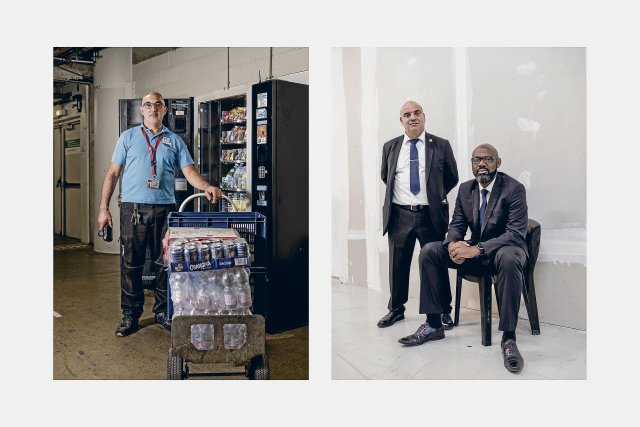People of the 21st century who work at the Pompidou Center and who are reminiscent of August Sander’s “People of the 20th Century”: supplier of the vending machines (based on Sanders’ “Confectioner” from 1928) and security guards (based on “Zöllner” from 1926)
Photo: Andreas Langfeld
The Center Georges Pompidou in Paris still looks like a spaceship. Flown here from the relaxed 70s, when art exhibitions were supposed to be democratic offers to look at and think about and not expensive events. The center is colorful, playful and postmodern in a good way: the important cables run on the outside of the building, which creates more space inside and you can go up with an outside escalator. It’s very big, but not that high – you only see it when you stand in front of it. As if the building was saying in a friendly way, “Come in and look at me.”
Part of the Center is currently visiting FMP 1 in Berlin. This event and office building, in which the editorial team of the “nd” is also located, also dates from the 1970s and is also not without fame; the newspaper used to have the entire building on six floors. Nowadays it is much more open and relaxed and presents, among other things, changing exhibitions to look at and think about, on a much smaller scale than the Center Pompidou, but free of charge.
The exhibition “Postures” is currently on view. They are portrait photographs of employees of the Center Pompidou, inspired by portrait photographs of August Sander (1876–1964), the founder of documentary photography in Germany. From his commercial photo studio in Cologne, he drove through the country to photograph the “people of the 20th century”. Across all milieus and classes, from the bourgeoisie to the proletariat. His portraits are of lasting sociological value for understanding habitus and context, especially of the 1920s.
nd.DieWoche – our weekly newsletter

With our weekly newsletter nd.DieWoche look at the most important topics of the week and read them Highlights our Saturday edition on Friday. Get your free subscription here.
In 2022 there was an exhibition at the Pompidou Center about this time in Germany with a focus on New Objectivity and August Sander. Florian Ebner, the art historian and head of the Center’s photographic collection, had the idea of letting Sander’s people of the 20th century interact with the 21st century, but he didn’t get the photo rights to the originals. That’s why he had them recreated together with the photographer Andreas Langfeld – as individual or group photos of the Center Pompidou’s employees at all levels, from the cleaning staff to the supervisory staff, the accounting staff, the curators to Renzo Piano, one of the Center’s architects . He has a green felt-tip pen in his hand because he used it to draw the very first sketches of the Center a long time ago.
Most of the people portrayed are quoted briefly and succinctly about their lives, their work and their ideas. An archivist sees himself as a “smuggler of memory,” a firefighter believes that “art is everywhere and everything is art,” and a library scientist sees her work as “the fan belt of a happy, restless science.” Some also cite other sources, for example the anarchist Peter Kropotkin (who is led by three curators who do not want to see themselves as “leaders” but as “comrades-in-arms” of the masses) or Aristotle (from the film collection employees) or Yoko Ono (from a librarian). A small minority allows themselves to be photographed without saying anything: they are chefs, waiters, project managers, lawyers and the administration director.
Everyone is photographed at their workplace, with and without poses. Additionally, there is a homeless woman and a few street musicians in front of the center (where homeless people are better tolerated than in the rest of Paris). As with Sander, it cuts across social classes, with interesting differences. In order to better understand this positioning, we recommend the clearly designed catalog for the exhibition, because each portrait is juxtaposed with an original Sander photo on the other side, but only as a title without an image because the rights are not available. There’s something both serious and playful about it. The people portrayed show and interpret their job, both situationally and historically, for example when today’s art educator is contrasted with Sander’s “Mr. Teacher” or the heads of the cleaning service with Sander’s “gas men”. The head of supervision is identified as a climate activist and holds a class struggle banner into the camera. In Sander’s case, the photo was called “Demonstration of the Red Front.” She says: “Instead of arguing in my corner about the fate of the oppressed, I take action where I can.”
The images seem unspectacular at first, but can develop a variety of political references: Who is pictured? How is each other understood? What does this have to do with society? What power does a workplace have? What can a photo actually do? If necessary, you should go look for the original Sanders. But it doesn’t have to be: their absence increases personal imagination. That’s how it always is with social fantasy. A very good exhibition.
»Postures / attitudes. People of the Pompidou Center – after August Sander”, until October 31st. FMP 1, Franz Mehring Platz 1, Berlin, daily 9 a.m. to 8 p.m. Catalog for €34 at Spector Books, Leipzig
Subscribe to the “nd”
Being left is complicated.
We keep track!
With our digital promotional subscription you can read all issues of »nd« digitally (nd.App or nd.Epaper) for little money at home or on the go.
Subscribe now!
